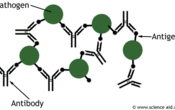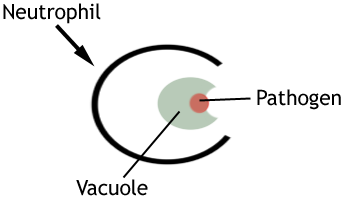Immune System and Response: Natural Defence, Cell Mediated Immuniuty, Antibodies and Lymphocytes
Edited by Jamie (ScienceAid Editor), Taylor (ScienceAid Editor), Jen Moreau, MaxScience
Natural Defence
We are constantly being bombarded with micro-organisms that could be harmful to us. The body has a number of methods to adapt, that will stop these ever gaining access to living cells. These natural defense mechanisms include:
| Mechanism | Explained |
|---|---|
| Skin | This is generally impenetrable as the outermost layer. The epidermis is toughened by collagen and keratin - an indigestible protein. On the skin surface are groups of bacteria called commensals, they compete (more successfully) with pathogenic bacteria. |
| Tears | eyes] are protected from pathogens by the enzyme lysozyme which breaks down cell walls. |
| Saliva | stomach]. |
| Mucus | Produced by cells in the respiratory tract, mucus traps microorganisms that may be inhaled like smoke or pollen. |
| Cilia | Small hair-like projections on the epithelial cells in the various parts of the body. The cilia move the mucus. |
Pathogens
If pathogens manage to get past these primary defenses, the body's cells will start to respond. The first type of response will be non-specific phagocytosis. This process is carried out by a number of different white blood cells, the most common being the neutrophils and macrophages. Once they have detected foreign material, the neutrophil will attach to the microorganism wall and then engulf and enclose the microorganism in the vacuole. Enzymes from the Golgi body are secreted, that digest the microorganism.
Macrophages
Macrophages perform the same process but do so outside of the blood vessels, so they might remove pathogens from the tissue fluid. Cells have molecules in their wall that identifies them. This is important for the body to identify foreign cells; so these are a bit like a passport. When these markers cause an immune response, they are called antigens. They can be proteins, polysaccharide or glycoprotein (a combination of protein and carbohydrate).
Antigens
Antigens are on the surfaces of microorganisms and viruses, allowing them to be detected. Tissue, even entire organs that are transplanted have normal cell markers, but when they aren't your own, they cause the immune system to attack the tissue - this is why people receiving transplants need to take immunosuppressants. Individual chemicals can also be antigens, toxins for example, but some people may treat harmless chemicals as antigens and so have an allergic response to them.
Cell Mediated Immunity: Lymphocytes
We now move in to look at specific immunity and the role of the T lymphocytes. They are made from stem cells in the bone marrow (soft tissue in bones). Then they pass to the thymus gland (sits above the heart), where the T-lymphocytes acquire their receptors specific to an antigen. The T lymphocytes travel in the lymphatic system until they recognize their specific antigen. When that happens, they divide rapidly and produce many clones of themselves. A type of T cell called killer T lymphocytes bind to the pathogen and produce cytotoxin that destroys cells.
Other types of lymphocyte are produced, including helper T-cells that stimulate macrophages and B cells; Viruses and Infection: Structure, Transmission, Avoiding Disease memory cells that cause immunity; and suppressor T cells that slow down the immune response about 1 week after the response.
Antibodies and B Lymphocytes
B lymphocytes are also made in the bone marrow and mature in lymph nodes where they acquire membrane receptors. The rapid reproduction of a specific B cell is caused by a macrophage that has an antigen in its membrane coming into contact with the B cell. A large number of cloned B cells secrete antibodies that kill the microorganism. Antibodies have the following structure.
Antibodies (or immunoglobulins) are made of chains of proteins joined by disulfide bridges: a very strong bond. The key part is the antigen-binding sites which binds to antigens, a bit like an enzyme does. Because each antibody has two binding sites, it can bind to two different pathogens, this causes large, lattice-like, structures called antibody-antigen complexes to form.
Antibodies cause different outcomes depending on their type. Outlined below are some of these.
| Outcome | Explanation |
|---|---|
| Agglutination of antigens. | Lots of microorganisms stick together, this is called agglutination. It makes it easier for macrophages to detect and engulf them. |
| Stimulation of phagocytosis. | The antibody causes phagocytosis (see above) to occur. |
| Precipitation of Toxins | Antibodies cause the soluble toxin to precipitate (become solid or not dissolved) and so it is rendered harmless. |
Questions and Answers
I am looking for some information or examples for my access course?
I need to Produce a document that summarizes the natural defence mechanisms of the human. I am seeking information or examples to create my own.
- The Immune system or White blood cells found in Bone Marrow, lymph nodes, spleen, thymus, and also in the liver of embryos.
- 1) The [Innate immune system] is a response that is non-specific and includes primary deterrents.
- 2) The [ Adaptive immune system] in cases where microorganisms penetrate primary deterrents a back-up is the adaptive immune system.
- 3) The [ Humoral immunity response] protects against bacteria and viruses found in bodily fluids.
- 4) The [ Cell-mediated immunity] protects against foreign organisms which have managed to infect body cells.
- 5) The [ Lymphatic system] responsible for transport of immune cells. Immune cells are produced in bone marrow.
Referencing this Article
If you need to reference this article in your work, you can copy-paste the following depending on your required format:
APA (American Psychological Association)
Immune System and Response: Natural Defence, Cell Mediated Immuniuty, Antibodies and Lymphocytes. (2017). In ScienceAid. Retrieved Apr 19, 2024, from https://scienceaid.net/biology/micro/immune.html
MLA (Modern Language Association) "Immune System and Response: Natural Defence, Cell Mediated Immuniuty, Antibodies and Lymphocytes." ScienceAid, scienceaid.net/biology/micro/immune.html Accessed 19 Apr 2024.
Chicago / Turabian ScienceAid.net. "Immune System and Response: Natural Defence, Cell Mediated Immuniuty, Antibodies and Lymphocytes." Accessed Apr 19, 2024. https://scienceaid.net/biology/micro/immune.html.
If you have problems with any of the steps in this article, please ask a question for more help, or post in the comments section below.
Comments
Article Info
Categories : Micro
Recent edits by: Jen Moreau, Taylor (ScienceAid Editor), Jamie (ScienceAid Editor)












